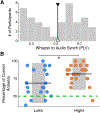Spontaneous synchronization to speech reveals neural mechanisms facilitating language learning
- PMID: 30833700
- PMCID: PMC6435400
- DOI: 10.1038/s41593-019-0353-z
Spontaneous synchronization to speech reveals neural mechanisms facilitating language learning
Abstract
We introduce a deceptively simple behavioral task that robustly identifies two qualitatively different groups within the general population. When presented with an isochronous train of random syllables, some listeners are compelled to align their own concurrent syllable production with the perceived rate, whereas others remain impervious to the external rhythm. Using both neurophysiological and structural imaging approaches, we show group differences with clear consequences for speech processing and language learning. When listening passively to speech, high synchronizers show increased brain-to-stimulus synchronization over frontal areas, and this localized pattern correlates with precise microstructural differences in the white matter pathways connecting frontal to auditory regions. Finally, the data expose a mechanism that underpins performance on an ecologically relevant word-learning task. We suggest that this task will help to better understand and characterize individual performance in speech processing and language learning.
Conflict of interest statement
Competing interests
The authors declare no competing interests.
Figures




References
-
- Condon WS & Sander LW Neonate movement is synchronized with adult speech: interactional participation and language acquisition. Science 183, 99–101 (1974). - PubMed
-
- Repp BH Sensorimotor synchronization: A review of the tapping literature. Psychonomic Bulletin and Review 12, 969–992 (2005). - PubMed
-
- Janata P & Grafton ST Swinging in the brain: Shared neural substrates for behaviors related to sequencing and music. Nature Neuroscience 6, 682–687 (2003). - PubMed
Methods-only references
-
- Rousseeuw PJ & Van Driessen K A fast algorithm for the minimum covariance determinant estimator. Technometrics 41, 212–223 (1999).
-
- Verboven S & Hubert M LIBRA: A MATLAB library for robust analysis. Chemom. Intell. Lab. Syst 75, 127–136 (2005).
-
- Cureton EE Rank-biserial correlation. Psychometrika 21, 287–290 (1956).
Publication types
MeSH terms
Grants and funding
LinkOut - more resources
Full Text Sources
Other Literature Sources

